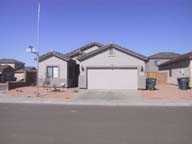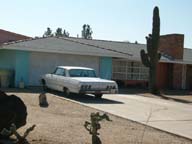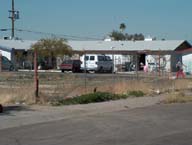The New vs. the OldThis small South Phoenix neighborhood is nestled against the north side of South Mountain. It expands from 14th Street to 15th Street and up to Dobbins Road. We are here conducting a survey of the landscape and subdivision identity. As Kevin Blake and Daniel Arreola did in their study entitled “Residential Subdivision Identity in Metropolitan Phoenix”, we first drive the perimeter of the subdivision to get a sense of place and to look for “turf markers”. This development has no name, but is clearly defined by a chain link fence and still untamed desert territory. Next, we go down each street taking notes and photographs. As we do this, we are recording the frequency of characteristics and examples of distinctive elements. We notice that there is no frequency in anything—each home is completely different. This diversity of characteristics is what makes the neighborhood so unique. A brand new home sits across the street from an old run-down one. We approach the owner of the older home. He has lived in this neighborhood for ten years. According to him, the community is tightly knit—everybody knows everybody. The residents even notice when an outsider enters the neighborhood. They have never had a Homeowners Association. He has no problem with the new houses popping up around him. In fact, he appreciates the increase in his property value. We thank him for his time and walk across the street to the new home. As we look back, we notice the man’s yard covered in trash and various knick-knacks. Several cars are parked out front. The plants are overgrown. It is an incredible contrast to the perfectly manicured yard of the new home in front of us. No one answered our knocks at the new home. Disappointed, I find myself imagining the viewpoint of the owner. We have just heard their neighbor’s favorable view of them, but is their view of their neighbor quite so flattering? I imagine not. If I were this owner, I would look out the front window of my beautiful new home and find myself disappointed with the view. I would wish that the people across the street would clean up their yard. I might even find myself wishing for an association that would enforce a strict standard of maintenance. These thoughts raise several questions. The diversity of this neighborhood is part of its charm, but do these new homeowners cherish that aspect of it? Are these new homeowners part of the closely-knit community, or are they alienated? The older homeowners have a “keep the old, in with the new” attitude. However, is the attitude of the new homeowners more reflective of the statement “out with the old, in with the new”? Or was it the diversity of the neighborhood that attracted the new homeowners in the first place? According to Blake and Arreola, personal identity in new subdivisions is not expressed through house style. Therefore, by selecting an older community for their home, the new homeowners are able to uniquely represent their identity. If only the owner was home, I might be able to find out. My classmate Julie also wrote about this neighborhood if you would like to know more. |
||
| Return to My Home Page | Contact: rachel.gregoire@asu.edu | |



